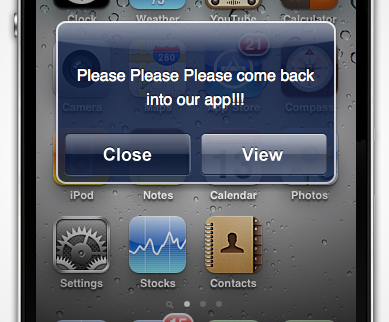Urban Airship CEO分析用户黏性意义大于下载量的原因
游戏邦注:本文原作者是Urban Airship首席执行官Scott Kveton,他列举了日本丰田汽车、华纳兄弟和《愤怒的小鸟》这三个例子来说明,用户黏重要性远大于应用下载量。
在过去三年,手机应用领域基本上是以数量取胜,成百上千万部移动设备的应用下载量达到了数十亿次,几乎是早期网络时代的翻版——当时大家重视的是独立访问用户数量和综合浏览量。但这些天文数字究竟会创造什么成果?
尽管实现数百万次的下载量的确可喜可贺,但它却并不等同于成功。开发者很难通过0.99美元的应用打造成功的项目,免费应用更是如此。
虽然下载量并非正确的衡量标准,但不少人还是试图将网络领域的准则用于移动领域,实际上我们对待新媒介时应该转变固有观念,以全新的途径来展示它的内容。
这一行业关注的重点已开始从下载量转向了用户黏性,所以很显然未来三年的赢家,将是那些知晓如何通过应用与用户进行互动的企业。
手机本身是一个目的性很强的平台,用户通常掏出手机时不是打电话、查看邮件,观看球赛,就是在排队的时候玩游戏。成功的开发者很清楚如何利用手机平台的这种特性,设计出持续增加用户黏性的体验,这种应用绝非静态展示内容的平面手册,或者其网站功能的翻版。
在用户黏性方面获得成功,或者遭遇滑铁卢的应用有不少,以下是游戏邦编译的其中三个案例:
丰田汽车:丰田汽车有一款iPhone应用,它实际上照搬了其网站的内容,支持用户选择自己的丰田车配置,并通过该应用获得相关报价信息。但问题是:多数用户想购买一辆新车时,他们会首先想到去应用商店下载该应用以获取有效信息吗?更重要的是:用户会经常访问这款应用吗?答案当然是否定的。所以丰田汽车也由此错失了增加用户黏性的机会。但假如这款应用添加了支持用户输入车辆识别号、提供丰田汽车重要消息和最新服务安排等功能,那么它也许就是另一种结局了。
另外,它其实还可以提供用户地理定位功能,通过信息推送服务提醒他们:前方不远处有个汽车维修点,如果你可在20分钟内到达,他们将以优惠20%的费用为车子更换润滑油。这才是用户所需要的价值所在,因为应用的卖点并不在于品牌,而是它所提供的服务,这一点才是用户最关心的内容。
华纳兄弟:该公司为旗下的《哈里波特》、《指环王》和《黑暗骑士》等成功的电影开发了数款应用。华纳兄弟充分认识到手机是一个新型的内容传播渠道,所以他们会及时提醒观众在电影院入座后安装该应用。虽然这些观众后来离开了电影院,但手机上却保留了华纳兄弟品牌的内容,他们就可以开始体验其中的乐趣,也会比较愿意下载该应用的更新版本。
《愤怒的小鸟》:芬兰开发商Rovio是一个聪明的团队。他们一开始就未雨绸缪,提前想到0.99美元应用的生命周期可能很短暂。所以他们一直在升级游戏版本,通过添加新内容,为原来的0.99美元产品创造更多附加价值。这款游戏也因此通过口碑传播迅速聚集了人气,现在已成为一个系列品牌,0.99美元的产品只是其中的项目之一。Rovio的策略就是持续用新内容吸引用户,不吝于为原有用户提供免费的新内容。
要打造成功的应用项目,开发者的目光一定要长远,不可局限于应用下载量。应该学会倾听用户的意见,根据他们的需求推出富有吸引力和价值的内容。因为手机应用并非用户无聊解闷时才看看的静态屏幕,而是一项刺激用户投入时间的服务。
要注意的是:用户有可能下载安装你的应用,但关键在于如何留住用户,将其转化为频频回访的忠实用户。如果不能实现这一点,那么再多的下载量也只是一个空洞的数据。(本文为游戏邦/gamerboom.com编译,转载请注明来源:游戏邦)
Why mobile app success is more than just download numbers
This discussion about mobile economy is one of the five themes we will be focusing on at theVentureBeat Mobile Summit, on April 25-26. We’ve carefully invited the top executives in mobile to discuss the biggest challenges of the day, which, if solved, can lead to much faster growth in the industry. And at our enterprise session, we’ll have top executives around the table from a number of companies, including Verizon, AT&T, Sybase, Qualcomm, Box.net, and more. (If you think you should be part of the discussion,you can apply for a ticket.)
Over the past three years, the mobile landscape has been dominated by big numbers. Hundreds of thousands of apps on millions of devices downloaded billions of times. It’s like the early days of the Web all over again. Think unique Website visitors and page views. A lot of numbers, but with what net result?
A million downloads can make for a nice story, but they really don’t tell anything interesting, and they don’t equal success. It’s very difficult to build a business on a $0.99 app, let alone on a free one.
Along with downloads being mobile’s incorrect measurement, we’ve seen executions missing just as often. People have been trying to take what worked on the Web and shove it at mobile. But the rules are different now, so you have to change how you think about, treat and present content within the new medium.
As the conversation shifts away from download data to engagement data, it’s clear that the winners in the next three years will be those brands that have figured out how to drive engagement and create a conversation with their users through their apps.
Mobile is, by its very nature, an intent-driven platform. You pick up your phone to make a phone call, check your email, look up sports scores or play a game while waiting in line. Successful mobile apps have learned to take advantage of the intent-driven nature of the mobile channel and have designed apps that create ongoing user engagement. They are not developing static brochure-ware apps or feature-by-feature replicas of their Websites.
Success and failure in mobile apps comes in all shapes and sizes:
Toyota: Toyota has an iPhone app that is effectively a website in-an-app. Users can configure and then get a quote for their Toyota of choice. The problem: would most people think to go to the app store when considering a new car purchase? But more importantly: Is this app one that users will launch again and again? Of course not. So Toyota has missed the opportunity for ongoing engagement.
What if instead, the Toyota app would let Toyota owners enter their VIN number for their car and be kept up-to-date on important recall information and service schedules.
Heck, it’s mobile: the app could see a user’s location and notify them, via push notification, that there is an empty service bay at the dealer just three blocks away: “Come in in the next 20 minutes and we’ll give you 20% off your oil change.” That is a real conversation providing engagement and value to the user. It’s because the story being sold isn’t about the brand, it’s about the user, which tends to be the stories customers actually care about.
Warner Brothers: Warner Brothers build apps for its successful film franchises. Think “Harry Potter,” “Lord of the Rings” and “The Dark Knight.” What Warner Brothers has realized is that mobile is a new channel for delivering content, new and existing. The studio prompts moviegoers to install the related app while in the seats at the theater. When they walk out after the film, they are taking the Warners brand on their phones and they are ready to engage with the franchise through game play and updates about the next installments.
Angry Birds: The folks at Rovio are no fools. In the early days they probably saw that $0.99 apps didn’t have much of a shelf life. They took it a step further and continued offering content for their users with that original $0.99. The app just kept getting better. People talked, people shared; they got their friends to play and install the game. They created a conversation by continually evolving the game.They now have a franchise, and the $.99 per app is only part of their story. They built their franchise by continually engaging users with the very content they loved, even though that content was delivered for free to existing users.
Mobile is more than download numbers. It’s about telling your customers a story they care about, engaging users in a valuable way, and delighting them. And what’s now possible is as futuristic as our missing jetpacks, and in some ways, better than we imagined. We just have to quit thinking about it as a dumb screen people stare at when they’re bored, and start thinking about it as a portal to their time; a responsibility we better respect.
Remember: You may only get one chance to get your app installed on a user’s device. Be sure to think hard about how you create a valuable conversation for both them and you as you develop your app. If you don’t, your downloads will be another example of empty numbers.(source:venturebeat)








































 闽公网安备35020302001549号
闽公网安备35020302001549号